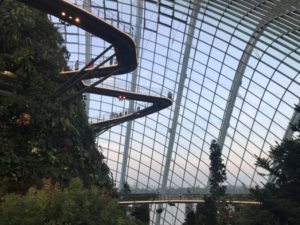Forty-one hours in Singapore.
I was invited by Walter Spano, from Mucciaccia and Partners, through Mario Pieroni, from RAM, orchestra director and Rebirth ambassador. I met Mario last at the end of July, he was in a meeting with Michelangelo. I was told that in September Mario would go to Singapore to organize the creation of a permanent installation of the Third Paradise at the National Technological University.
They knew perfectly well that I would say “Ok, I’ll have to go too”, not to follow the installation process, for which Mario didn’t need my help, but for the prospect of a partnership with an important Asian university.
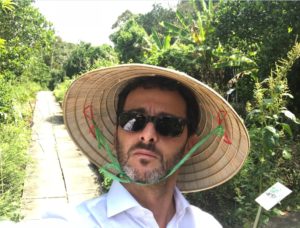
So now I’m here, in Singapore, an independent country for 52 years. The most expensive city in the world but also with the highest standard of living (for people who can afford it). I’ve found out that the NTU is a colossus: it’s the most important university not only in Singapore, but probably in the whole of Asia, according to some rankings. Walter welcomes us, a brilliant representative of that world class who simultaneously lives in different continents, for whom travelling from New York to Hong Kong is like going from Turin to Milan. He tells us about himself and Singapore while the car takes us to the hotel where Mario and I will have breakfast and, exhausted, will fall asleep for almost three hours. Then Walter comes to pick us up and take us to the National Technological University, local (but global) partner of this project. Driving past trees imported from Africa for their ability to lower the temperature under themselves by quite a few degrees, Walter outlines with precision the big “performance” (the definition is mine, meaning the pretence that everything is fine, the huge collective fiction) in which we live since the finance has been out of control, becoming 10 times bigger that the economy, but above all since the debts of banks and nations have reached extraordinarily huge proportions. And since the financial derivatives have multiply themselves in unaccounted ways: where are they? who’s pulling the strings?
We arrive at the NTU in a contrast between talks of the inevitability of the burst of the financial bubble and the flawless of the probably about 15 kilometres of road without so much as a piece of paper or a leaf on the ground, travelled by slow cars respecting the safety distance, all strangely new, I doubt mine would be allowed to circulate with all the bumps and scratches it shows off with the pride of a people carrier.
We get to the School of Art Media and Design. Its buildings modern and flawless too. Andrea Nanetti, associate chair – research, is there to welcome us. He has long curly hair and an elegant swing in his step. He tells us a few anecdotes from his life and career. Before joining this university, he was in architecture and business. Andrea works at the Design and Media Academy. His research has many points of contact with our philosophy, from the artivation to the Forums. And the whole vision of the University is in harmony with the Third Paradise: science and technology, what can they do for us and our planet? Andrea explains the NTU to us.
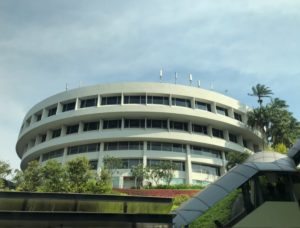
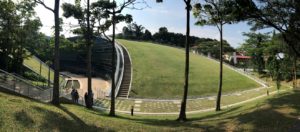
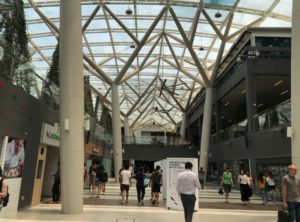
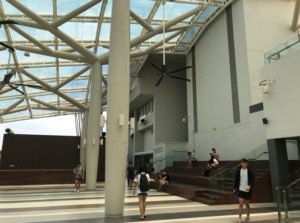
Andrea tells us about its structure and its history. In the last ten years the University (born as the only Chinese university outside of the Chinese territory, but now completely Singaporean) has received a 20 billion Singaporean dollar investment. About 13 billion euros. More or less the equivalent of my annual wages. Mine and the ones of 200.000 people like me. If we joined forces, us 200.000 plus one, we would manage to build a university like the NTU, in a year. As long as we didn’t spend a single euro. The Lega Nord, on its own, would take 277 years to amass that much, if it used all the electoral reimbursements in instalments of 47 million a year. But in 277 years they might have found other ways, and we might not need universities anymore, nor the Lega Nord, nor electoral reimbursements.
But back to us, we have been invited to collaborate with the Design and Media Academy.
We then go out. There is a little bus waiting for us. It’s extremely hot and humid. But in the bus – like in every other indoor space – the air is conditioned. The bus is Asians-size thought. Pieroni, Walter Spano and I make room for ourselves butting our heads against the roof. And while driving on the wrong side of the road (being in a former British colony), we see the residencies of professors and students, and the different department buildings. 35.000 people live in this university compound, but everything is all perfectly clean and organized; we are in Singapore after all, what else would you expect?
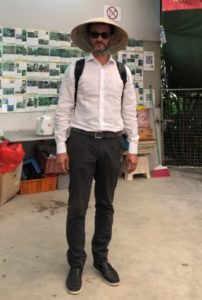 This is an island country, first gaining independence from the UK and then abandoned by its big sister (I wonder in what way ‘big’…), Malaysia. In the ‘50s there was a famous speech by Lee Kuan Yew, the nation’s founding father. They didn’t have anything. Swamps and the ocean. Now they are an economic, financial and military power (three things that often go together, actually). Ethics, authoritarianism, reliability, work, the communists back to China, finance and taxation and who knows what else, no dissent thanks, my taxi driver clearly says, an Indian guy in his ‘60s who has been a taxi driver for 28 years, after working on board of merchant ships; I’m going to digress here, the collaboration with the NTU will continue in the next paragraph if you’d rather move on: I sit at the front of the car, next to him, he’s taking me to the airport, I just need to ask him “and so, do you live well here?” and his words start flowing, I only manage to make him listen to me interrupting him to enquire about very personal things, like why he’s decided to leave Hinduism to become Christian (because when he was 30 he decided that it didn’t make sense to pray at statues, as they are made by men).
This is an island country, first gaining independence from the UK and then abandoned by its big sister (I wonder in what way ‘big’…), Malaysia. In the ‘50s there was a famous speech by Lee Kuan Yew, the nation’s founding father. They didn’t have anything. Swamps and the ocean. Now they are an economic, financial and military power (three things that often go together, actually). Ethics, authoritarianism, reliability, work, the communists back to China, finance and taxation and who knows what else, no dissent thanks, my taxi driver clearly says, an Indian guy in his ‘60s who has been a taxi driver for 28 years, after working on board of merchant ships; I’m going to digress here, the collaboration with the NTU will continue in the next paragraph if you’d rather move on: I sit at the front of the car, next to him, he’s taking me to the airport, I just need to ask him “and so, do you live well here?” and his words start flowing, I only manage to make him listen to me interrupting him to enquire about very personal things, like why he’s decided to leave Hinduism to become Christian (because when he was 30 he decided that it didn’t make sense to pray at statues, as they are made by men).
What’s the sense in that, he asks. And I’m about to tell him why that makes much more sense than worshipping the dreams and the fairy tales we have invented, at least statues exist, they are here, among us all, and some of them are so beautiful you feel like talking to them, some talk to cats, some to dead people, some to Indian taxi drivers on the streets of Singapore, why can’t we talk to statues? But he doesn’t give me the chance to tell him, he is a professional speaker, he’s been doing it for 28 years, creating this taxi-stage for himself, the opposite of a maxi-theatre, but a theatre nonetheless; and we are his audience, extras, ghosts. He’s there on his stage inside a taxi, the spotlight hits the space behind the wheel illuminating his white hair and fluffy moustache, his dark skin; I get to the airport in time, knowing I won’t see him ever again, I only hope he will let his daughter go to New Zealand, old man, she must make her mistakes like you’ve made yours, and I mine, with or without statues, and Singapore with its authoritarian democracy has turned into an Asian Switzerland, richer, but less liberal.
Malaysia and Indonesia are harassing Singapore, and it must protect itself. Walter talks about it too, so full of admiration and disenchantment that it’s hard to understand what he really thinks, unless we accept that he might think contradictory things, as we all do, as part of our structural make up. It might be different in 277 years. But we are back on the little bus, let’s forget about the taxi, which comes later in the story, to take me to the airport. We are still surveying the university grounds. And like that, casually, someone mentions a herb garden. It was Suzanneh who said and then there is also a herb garden, here in the compound.
A herb garden? I ask. Please, can we see that?
And this leads to the crazy chapter of this story, in which we meet him, the old Chinese man who cures (even fourth stage) cancer with medicinal herbs only he knows. I knew he existed, but I thought in Spielberg’s films only. While he is there in front of me. He has created this community herb garden. People work here as volunteers. It’s a huge area, considering that it started as a squatting occupation to become a valuable asset for the university thanks to its success. It welcomes doctors and researchers from all over the world, even from loved/hated America. There are newspaper cuttings and pictures everywhere. And the proofs. He’s got proofs. And he shows them to me. They are medical reports. Names and surnames, diagnoses, tests. They are in English but they might as well be in Chinese: what do I know about tumours and fourth stage lymphomas and those tests? My naivety makes me believe him immediately, without reservations. Ignorance and magic, we know, have been going hand in hand for a long time. But then I think of the stories of Rossana Becarelli, distinguished doctor and health director as well as an eminent Third Paradise Ambassador, and I tell myself that there is at least as much wisdom in that ignorance as ignorance in the wisdom of Western medicine. I wonder if this is not another sign: one of the most advanced scientific and technological universities in the world accommodates and supports a place like this! And I’m here to talk about the Third Paradise, the harmonic union between nature and artifice, between nature’s and mankind’s intelligences.
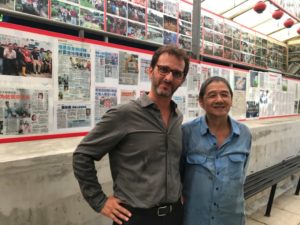
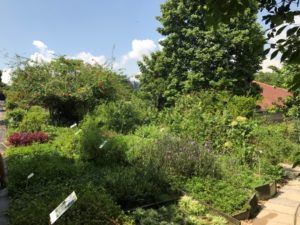
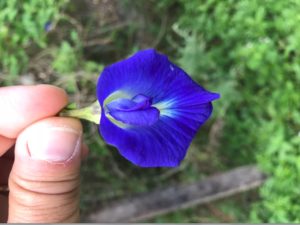
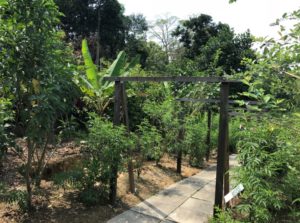
It is time to go. They cover us in mosquito repellent. A Vietnamese rice harvester’s hat on my head and off we go, to the Chinese medicinal garden. Dozens, hundreds of plants. Their scientific names in Latin are followed by the splendid scrawls of the ideograms. They show us the one for arrhythmia, the one for diabetes, the one for persistent cough, the one for hypertension and the two best selling drug products: the one to lose weight and the one to make the erection last longer. Two musts! But there are others more appropriate for the Third Paradise installation. One of an intense red, for example: it is used on wounds. It makes them heal quickly and deeply. In the next few days, Andrea and Walter will delve into their technical, botanical, farming, caring and sowing aspects, and they will send Michelangelo and me a list of plants from which to choose at least two. These plants shouldn’t have long roots! Because Andrea has already had a thought about where to position the work. And it looks like it has been okayed. Nothing less than the lawn on the roof top of the Academy building, the most iconic and photographed of the University. You can walk on it, going up from the ground level to the fifth floor. The installation would have maximum visibility.
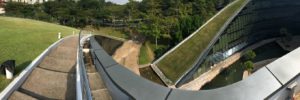
Here are the pictures of three things I particularly noticed during my visit:
1. the sports facilities
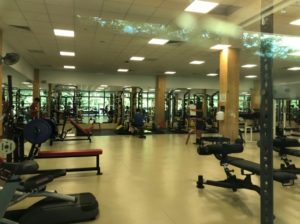

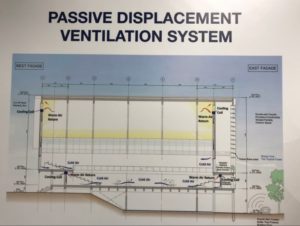
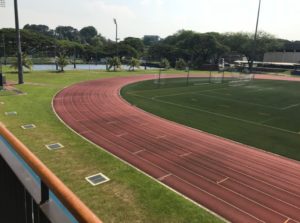
2. didactics spaces and model: some of the new classrooms (still very few) are designed according to the circular model typical of the distribution of processes of production and exchange of knowledge. It means that there’s no professor’s desk facing the students’ desks, but round tables scattered around to fill the room, with big screens on the walls operated from the tables, and the professor presumably walks around the room or sits at the tables moving from one another. It is the same model I saw in Melbourne. And in some open air raves, where the DJ disappears and people dance spreading across the whole space vaguely forming a circle.

3. and the canteen. I have seen many, usually sad and serving food inspiring little confidence, especially to someone like me who gets his supplies mainly from Let Eat Bi. At the NTU the variety is endless. More than twenty restaurants. Cuisine from different traditions, fresh produce, a wide choice for vegetarians…

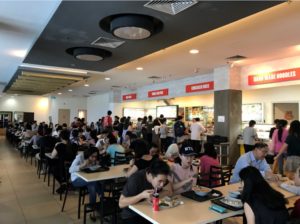
And that’s how my visit to the University ends. Sitting at a table.
Followed by a couple of hours in the city. Before that, Pieroni, Walter Spano and I have to pop to the Mucciaccia and Partners Gallery, where measurements are being taken for one of Michelangelo’s exhibitions, an essential mechanism of this system. Flag buildings along the road.
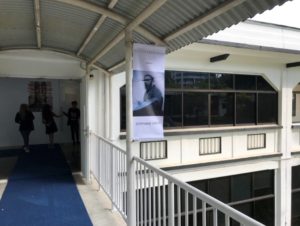
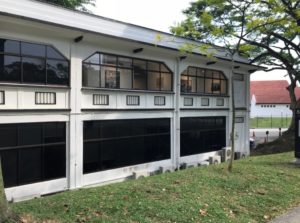

Like the iconic (and I reckon beautiful, it looked like the order of chaos to me) complex designed by Zaha Hadid.
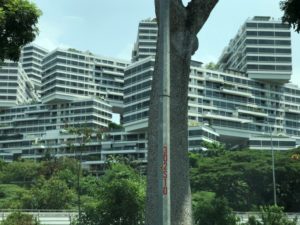
But another is the image that represents my (superficial and sketchy) idea of this country. It was waiting for me in one of the most touristic areas of the city, I am told visited by millions of people each year: it is the rainforest dome. Within a huge glass and steel building, an actual rainforest and its (air conditioned!) micro-climate have been recreated. First on a lift and then on foot you reach a dizzying height of fifty metres or more. The path winds hanging inside and outside of a structure covered in luxurious vegetation. It is breath-taking. You are left enchanted.
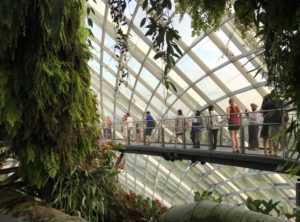
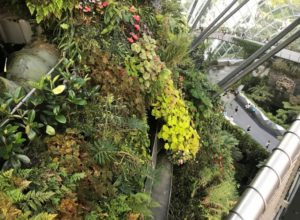
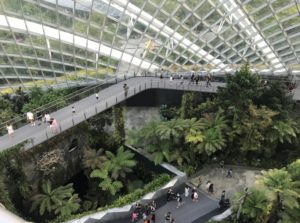
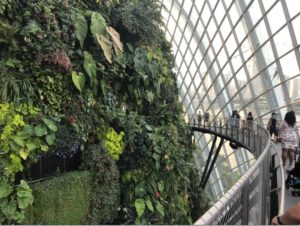
And that’s the image that struck me: suspended at an impossible height above the ground, the inhabitants of this country walk, orderly and safely, no threat seems to be looming over them, there are no thieves or robbers, they follow the path enjoying the show set up for them: tamed nature, enchanted in fictitious harmony with the building and its iper-technological artificial apparatus, a harmony between plants and humans, the same harmony, it is said, existing within social groups, their institutions, the government, the police. I am left with a sense of anxiety, an apprehension I can feel under my skin, like a dog sensing an earthquake, while humans are still busy, lost and content in the illusion that everything is fine. The dog doesn’t know if it has actually sensed something, or what. It might be a mistake, so it stands there, like the humans, and where could it go anyway? If the earthquake strikes it will be hit too. He can only look around itself hoping for a sign. But then a smell, a movement, a desire distracts him.

